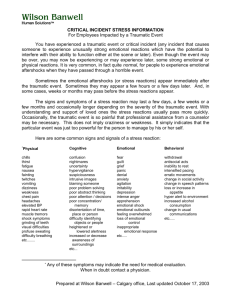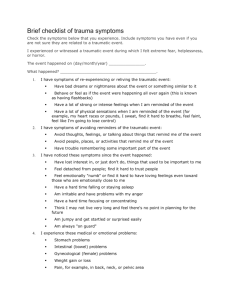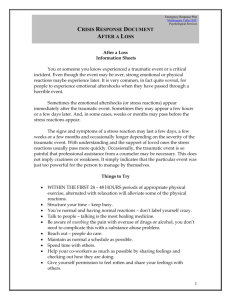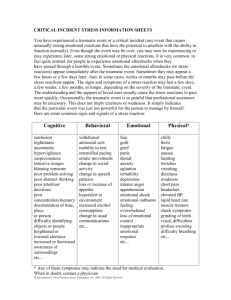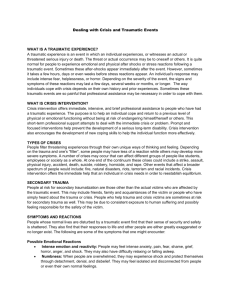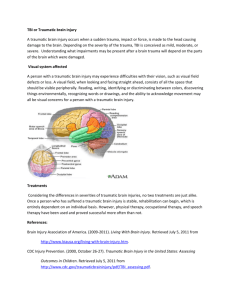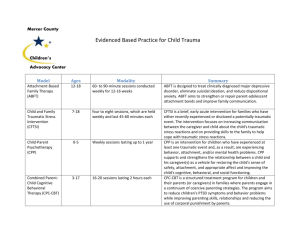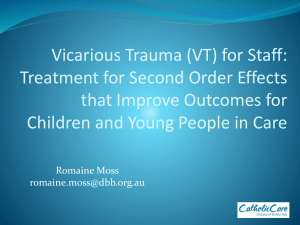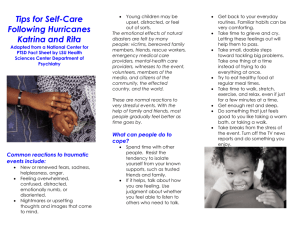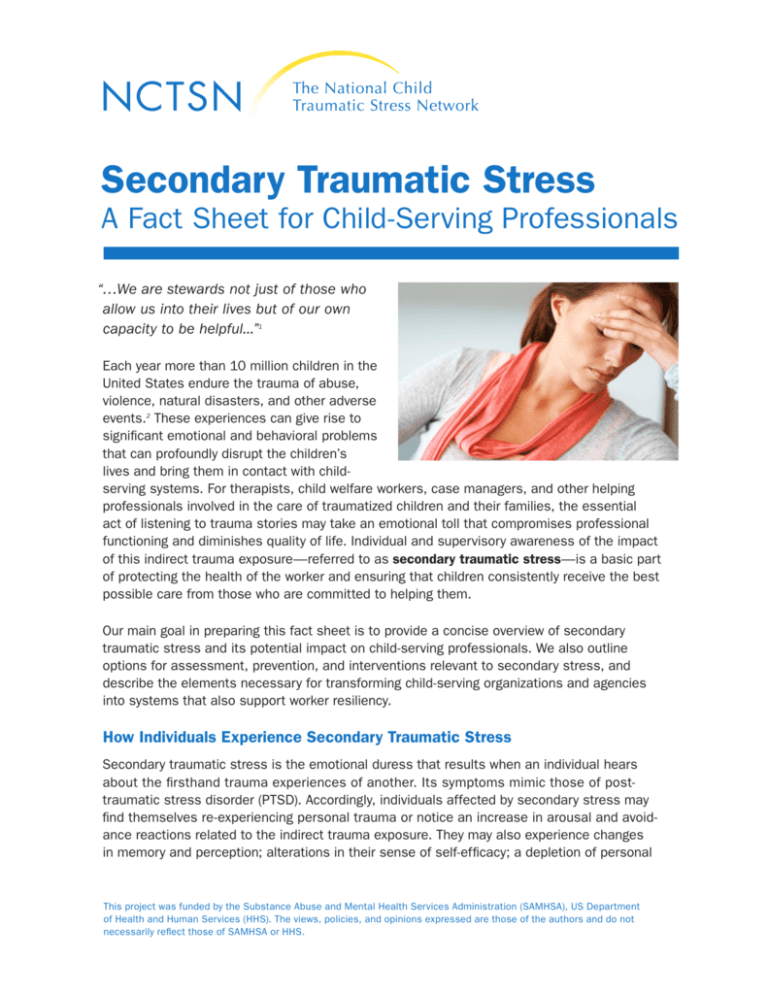
Secondary Traumatic Stress
A Fact Sheet for Child-Serving Professionals
“…We are stewards not just of those who
allow us into their lives but of our own
capacity to be helpful...”1
Each year more than 10 million children in the
United States endure the trauma of abuse,
violence, natural disasters, and other adverse
events.2 These experiences can give rise to
significant emotional and behavioral problems
that can profoundly disrupt the children’s
lives and bring them in contact with childserving systems. For therapists, child welfare workers, case managers, and other helping
professionals involved in the care of traumatized children and their families, the essential
act of listening to trauma stories may take an emotional toll that compromises professional
functioning and diminishes quality of life. Individual and supervisory awareness of the impact
of this indirect trauma exposure—referred to as secondary traumatic stress—is a basic part
of protecting the health of the worker and ensuring that children consistently receive the best
possible care from those who are committed to helping them.
Our main goal in preparing this fact sheet is to provide a concise overview of secondary
traumatic stress and its potential impact on child-serving professionals. We also outline
options for assessment, prevention, and interventions relevant to secondary stress, and
describe the elements necessary for transforming child-serving organizations and agencies
into systems that also support worker resiliency.
How Individuals Experience Secondary Traumatic Stress
Secondary traumatic stress is the emotional duress that results when an individual hears
about the firsthand trauma experiences of another. Its symptoms mimic those of posttraumatic stress disorder (PTSD). Accordingly, individuals affected by secondary stress may
find themselves re-experiencing personal trauma or notice an increase in arousal and avoidance reactions related to the indirect trauma exposure. They may also experience changes
in memory and perception; alterations in their sense of self-efficacy; a depletion of personal
This project was funded by the Substance Abuse and Mental Health Services Administration (SAMHSA), US Department
of Health and Human Services (HHS). The views, policies, and opinions expressed are those of the authors and do not
necessarily reflect those of SAMHSA or HHS.
resources; and disruption in their perceptions of safety, trust, and independence. A partial list
of symptoms and conditions associated with secondary traumatic stress includes3
n
Hypervigilance
n
Hopelessness
n
Inability to embrace complexity
n
Inability to listen, avoidance of clients
n
Anger and cynicism
n
Sleeplessness
n
Fear
Secondary traumatic stress refers to the
presence of PTSD symptoms caused by at
least one indirect exposure to traumatic
material. Several other terms capture
elements of this definition but are not all
interchangeable with it.
n
Chronic exhaustion
n
n
Physical ailments
n
Minimizing
n
Guilt
Secondary Traumatic Stress
and Related Conditions:
Sorting One from Another
Compassion fatigue, a label proposed by
Figley4 as a less stigmatizing way to describe
secondary traumatic stress, has been used
interchangeably with that term.
Vicarious trauma refers to changes
in the inner experience of the therapist
resulting from empathic engagement with a
traumatized client.13 It is a theoretical term
that focuses less on trauma symptoms
and more on the covert cognitive changes
that occur following cumulative exposure to
another person’s traumatic material. The
primary symptoms of vicarious trauma are
disturbances in the professional’s cognitive
frame of reference in the areas of trust,
safety, control, esteem, and intimacy.
n
Clearly, client care can be compromised if the
therapist is emotionally depleted or cognitively
affected by secondary trauma. Some traumatized professionals, believing they can no longer
be of service to their clients, end up leaving
their jobs or the serving field altogether. Several
studies have shown that the development of
secondary traumatic stress often predicts that
the helping professional will eventually leave the
field for another type of work.4,5
Understanding Who is at Risk
The development of secondary traumatic stress
is recognized as a common occupational hazard
for professionals working with traumatized
children. Studies show that from 6% to 26% of
therapists working with traumatized populations,
and up to 50% of child welfare workers, are at
high risk of secondary traumatic stress or the
related conditions of PTSD and vicarious trauma.
Any professional who works directly with
traumatized children, and is in a position to
Burnout is characterized by emotional
exhaustion, depersonalization, and a reduced
feeling of personal accomplishment. While
it is also work-related, burnout develops as
a result of general occupational stress; the
term is not used to describe the effects of
indirect trauma exposure specifically.
n
Compassion satisfaction refers to the
positive feelings derived from competent
performance as a trauma professional. It is
characterized by positive relationships with
colleagues, and the conviction that one’s
work makes a meaningful contribution to
clients and society.
n
Secondary Traumatic Stress: A Fact Sheet for Child-Serving Professionals
The National Child Traumatic Stress Network
www.NCTSN.org
2
hear the recounting of traumatic experiences, is at risk of secondary traumatic stress. That
being said, risk appears to be greater among women and among individuals who are highly
empathetic by nature or have unresolved personal trauma. Risk is also higher for professionals
who carry a heavy caseload of traumatized children; are socially or organizationally isolated;
or feel professionally compromised due to inadequate training.6-8 Protecting against the
development of secondary traumatic stress are factors such as longer duration of professional
experience, and the use of evidence-based practices in the course of providing care.7
Identifying Secondary Traumatic Stress
Supervisors and organizational leaders
in child-serving systems may utilize a
variety of assessment strategies to help
them identify and address secondary
traumatic stress affecting staff
members.
The most widely used approaches are
informal self-assessment strategies,
usually employed in conjunction with
formal or informal education for the
worker on the impact of secondary traumatic stress. These self-assessment
tools, administered in the form of questionnaires, checklists, or scales, help
characterize the individual’s trauma
history, emotional relationship with work and the work environment, and symptoms or experiences that may be associated with traumatic stress.4,9
Supervisors might also assess secondary stress as part of a reflective supervision model.
This type of supervision fosters professional and personal development within the context of
a supervisory relationship. It is attentive to the emotional content of the work at hand and
to the professional’s responses as they affect interactions with clients. The reflective model
promotes greater awareness of the impact of indirect trauma exposure, and it can provide a
structure for screening for emerging signs of secondary traumatic stress. Moreover, because
the model supports consistent attention to secondary stress, it gives supervisors and
managers an ongoing opportunity to develop policy and procedures for stress-related issues
as they arise.
Formal assessment of secondary traumatic stress and the related conditions of burnout,
compassion fatigue, and compassion satisfaction is often conducted through use of the
Professional Quality of Life Measure (ProQOL).7,8,10,11 This questionnaire has been adapted to
measure symptoms and behaviors reflective of secondary stress. The ProQOL can be used
at regular intervals to track changes over time, especially when strategies for prevention or
intervention are being tried.
Secondary Traumatic Stress: A Fact Sheet for Child-Serving Professionals
The National Child Traumatic Stress Network
www.NCTSN.org
3
Strategies for Prevention
Prevention
A multidimensional approach to prevention and
n Psychoeducation
intervention—involving the individual, supervisors,
n Clinical supervision
and organizational policy—will yield the most
n Ongoing skills training
positive outcomes for those affected by secondary
n Informal/formal self-report screening
traumatic stress. The most important strategy
n Workplace self-care groups
for preventing the development of secondary
(for example, yoga or meditation)
traumatic stress is the triad of psychoeducation,
n Creation of a balanced caseload
skills training, and supervision. As workers
n Flextime scheduling
gain knowledge and awareness of the hazards
n Self-care accountability buddy system
of indirect trauma exposure, they become
n Use of evidence-based practices
empowered to explore and utilize prevention
n Exercise and good nutrition
strategies to both reduce their risk and increase
their resiliency to secondary stress. Preventive
strategies may include self-report assessments,
participation in self-care groups in the workplace, caseload balancing, use of flextime
scheduling, and use of the self-care accountability buddy system. Proper rest, nutrition,
exercise, and stress reduction activities are also important in preventing secondary
traumatic stress.
Strategies for Intervention
Although evidence regarding the effectiveness
of interventions in secondary traumatic stress
is limited, cognitive-behavioral strategies and
mindfulness-based methods are emerging as best
practices. In addition, caseload management,
training, reflective supervision, and peer
supervision or external group processing have been
shown to reduce the impact of secondary traumatic
stress. Many organizations make referrals for
formal intervention from outside providers such
as individual therapists or Employee Assistance
Programs. External group supervision services may
be especially important in cases of disasters or
community violence where a large number of staff
have been affected.
Intervention
n
Strategies to evaluate secondary
stress
n
Cognitive behavioral interventions
n
Mindfulness training
n
Reflective supervision
n
Caseload adjustment
n
Informal gatherings following crisis
events (to allow for voluntary,
spontaneous discussions)
n
Change in job assignment or work
group
n
Referrals to Employee Assistance
Programs or outside agencies
The following books, workbooks, articles, and self-assessment tests are valuable resources
for further information on self-care and the management of secondary traumatic stress:
n
Volk, K.T., Guarino, K., Edson Grandin, M., & Clervil, R. (2008). What about You? A Workbook for Those Who Work with Others. The National Center on Family Homelessness.
http://508.center4si.com/SelfCareforCareGivers.pdf
Secondary Traumatic Stress: A Fact Sheet for Child-Serving Professionals
The National Child Traumatic Stress Network
www.NCTSN.org
4
n
Self-Care Assessment Worksheet
http://www.ecu.edu/cs-dhs/rehb/upload/Wellness_Assessment.pdf
n
Hopkins, K. M., Cohen-Callow, A., Kim, H. J., Hwang, J. (2010). Beyond intent to leave:
Using multiple outcome measures for assessing turnover in child welfare. Children and
Youth Services Review, 32,1380-1387.
n
Saakvitne, K. W., Pearlman, L. A., & Staff of TSI/CAAP. (1996). Transforming the Pain: A
Workbook on Vicarious Traumatization. New York: W.W. Norton.
n
Van Dernoot Lipsky, L. (2009). Trauma Stewardship: An everyday guide to caring for self while
caring for others. San Francisco: Berrett-Koehler Publishers.
n
Compassion Fatigue Self Test
http://www.ptsdsupport.net/compassion_fatugue-selftest.html
n
ProQOL 5 http://proqol.org/ProQol_Test.html
n
Rothschild, B. (2006). Help for the helper. The psychophysiology of compassion fatigue and
vicarious trauma. New York: W.W. Norton.
Worker Resiliency in Trauma-informed Systems: Essential Elements
Both preventive and interventional strategies for secondary traumatic stress should
be implemented as part of an organizational risk-management policy or task force that
recognizes the scope and consequences of the condition. The Secondary Traumatic Stress
Committee of the National Child Traumatic Stress Network has identified the following
concepts as essential for creating a trauma-informed system that will adequately address
secondary traumatic stress. Specifically, the trauma-informed system must
n
Recognize the impact of secondary trauma on the workforce.
n
Recognize that exposure to trauma is a risk of the job of serving traumatized children
and families.
n
Understand that trauma can shape the culture of organizations in the same way that
trauma shapes the world view of individuals.
n
Understand that a traumatized organization is less likely to effectively identify its clients’
past trauma or mitigate or prevent future trauma.
n
Develop the capacity to translate trauma-related knowledge into meaningful action, policy,
and improvements in practices.
These elements should be integrated into direct services, programs, policies, and
procedures, staff development and training, and other activities directed at secondary
traumatic stress.
“We have an obligation to our clients, as well as to ourselves, our colleagues
and our loved ones, not to be damaged by the work we do.”12
Secondary Traumatic Stress: A Fact Sheet for Child-Serving Professionals
The National Child Traumatic Stress Network
www.NCTSN.org
5
References
1. Conte, JR. (2009). Foreword. In L. Van Dernoot Lipsky, Trauma stewardship. An everyday guide to
caring for self while caring for others (p. xi). San Francisco: Berrett-Koehler Publishers, Inc.
Available at: http://traumastewardship.com/foreword.html Accessed June 12, 2011.
2. National Center for Children Exposed to Violence (NCCEV). (2003).
Available at: http://www.nccev.org/violence/index.html Accessed June 5, 2011.
3. Van Dernoot Lipsky, L. (2009). Trauma Stewardship: An everyday guide to caring for self while caring for
others. San Francisco: Berrett-Koehler Publishers.
4. Figley, C.R. (1995). Compassion fatigue as secondary traumatic stress disorder: An overview. In C.R.
Figley (Ed.), Compassion fatigue: Coping with secondary traumatic stress disorder in those who treat the
traumatized (pp. 1-20). New York, NY: Brunner/Mazel.
5. Pryce, J.G., Shackelford, K.K., Price, D.H. (2007). Secondary traumatic stress and the child welfare
professional. Chicago: Lyceum Books, Inc.
6. Bride, B.E., Hatcher, S.S., & Humble, M.N. (2009). Trauma training, trauma practices, and secondary
traumatic stress among substance abuse counselors. Traumatology, 15, 96-105.
7. Craig, C.D., & Sprang, G. (2010). Compassion satisfaction, compassion fatigue, and burnout in a
national sample of trauma treatment therapists. Anxiety, Stress, & Coping, 23(3), 319-339.
8. Sprang, G., Whitt-Woosley, A., & Clark, J. (2007). Compassion fatigue, burnout and compassion
satisfaction: Factors impacting a professional’s quality of life. Journal of Loss and Trauma, 12, 259-280.
9. Figley, C.R. (2004, October). Compassion Fatigue Therapist Course Workbook. A Weekend Training
Course. Green Cross Foundation. Black Mountain, NC.
Available at: http://www.gbgm-umc.org/shdis/CFEWorkbook_V2.pdf
10. Stamm, B.H. (2010). The concise ProQOL manual, 2nd Ed. Pocatello, ID: ProQOL.org.
Available at: http://www.proqol.org/uploads/ProQOL_Concise_2ndEd_12-2010.pdf
11. Stamm, B.H., Figley, C.R., & Figley, K.R. (2010, November). Provider Resiliency: A Train-the-Trainer Mini
Course on Compassion Satisfaction and Compassion Fatigue. International Society for Traumatic Stress
Studies. Montreal, Quebec, Canada.
12. Saakvitne, K. W., & Pearlman, L. A., & Staff of TSI/CAAP. (1996). Transforming the Pain: A Workbook
on Vicarious Traumatization. New York: W.W. Norton.
13. Pearlman, L. A., & Saakvitne, K.W. (1995). Treating therapists with vicarious traumatization and
secondary traumatic stress disorders. In C.R. Figley (Ed.), Compassion fatigue: Coping with secondary
traumatic stress disorder in those who treat the traumatized (pp. 150-177). New York, NY: Brunner/Mazel.
Recommended Citation
National Child Traumatic Stress Network, Secondary Traumatic Stress Committee. (2011). Secondary traumatic stress: A fact
sheet for child-serving professionals. Los Angeles, CA, and Durham, NC: National Center for Child Traumatic Stress.
Copyright © 2011, National Center for Child Traumatic Stress on behalf of Ginny Sprang, PhD, Leslie Anne Ross, PsyD, and the
National Child Traumatic Stress Network. This work was funded by the Substance Abuse and Mental Health Services Administration (SAMHSA), US Department of Health and Human Services (HHS), which retains for itself and others acting on its behalf
a nonexclusive, irrevocable worldwide license to reproduce, prepare derivative works, and distribute this work by or on behalf of
the Government. All other rights are reserved by the copyright holder(s).
About the National Child Traumatic Stress Network
Established by Congress in 2000, the National Child Traumatic Stress Network (NCTSN) is a unique collaboration of academic
and community-based service centers whose mission is to raise the standard of care and increase access to services for
traumatized children and their families across the United States. Combining knowledge of child development, expertise in the
full range of child traumatic experiences, and attention to cultural perspectives, the NCTSN serves as a national resource for
developing and disseminating evidence-based interventions, trauma-informed services, and public and professional education.

